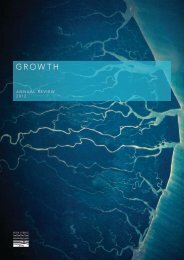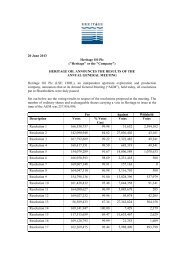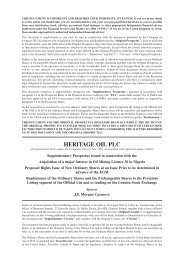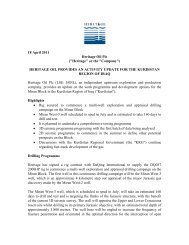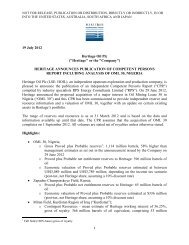Prospectus re Admission to the Official List - Heritage Oil
Prospectus re Admission to the Official List - Heritage Oil
Prospectus re Admission to the Official List - Heritage Oil
Create successful ePaper yourself
Turn your PDF publications into a flip-book with our unique Google optimized e-Paper software.
RPS Energy<strong>Heritage</strong> <strong>Oil</strong> – Competent Persons ReportFigu<strong>re</strong> 28: RPS Top Reservoir Depth Map, Block 122FEB200803432250The maximum size of <strong>the</strong> structu<strong>re</strong>s in Block 1 range from 5 <strong>to</strong> 69 sq km. <strong>Heritage</strong> mapping is based on astrong <strong>re</strong>flec<strong>to</strong>r which <strong>the</strong>y interp<strong>re</strong>t, based on seismic facies, <strong>to</strong> be <strong>the</strong> <strong>to</strong>p of a sandy sequence. Theinterp<strong>re</strong>tation of this unit is very robust as <strong>the</strong> seismic quality is very good. <strong>Heritage</strong> has identifiedamplitude anomalies at <strong>the</strong> c<strong>re</strong>st of structu<strong>re</strong>s throughout <strong>the</strong> block which could be indicative ofhydrocarbon fill although <strong>the</strong> anomalies do not cover <strong>the</strong> enti<strong>re</strong> a<strong>re</strong>a of <strong>the</strong> larger prospects. The concernthat any oil might be biodegraded due <strong>to</strong> <strong>the</strong> very shallow <strong>re</strong>servoir depth is partly allayed by <strong>the</strong> p<strong>re</strong>senceof <strong>re</strong>latively light oil in <strong>the</strong> Paraa oil seep (Section 5.3).As in Block 3A, <strong>Heritage</strong> has used time structu<strong>re</strong> maps <strong>to</strong> determine <strong>the</strong> extent of prospects and a<strong>re</strong>as forvolumes. RPS has <strong>re</strong>-gridded <strong>the</strong> mapped horizons and depth converted <strong>the</strong>m using average velocitiescalculated from <strong>the</strong> time-depth <strong>re</strong>lationship seen at Kingfisher-1.It is st<strong>re</strong>ssed that prior <strong>to</strong> <strong>the</strong> completion of <strong>the</strong> ongoing seismic programmes, large a<strong>re</strong>as of both blocks,particularly <strong>the</strong> north of Block 1A a<strong>re</strong> still <strong>re</strong>latively unexplo<strong>re</strong>d, although high <strong>re</strong>solution satellite data isunders<strong>to</strong>od <strong>to</strong> show <strong>the</strong> p<strong>re</strong>sence of some potentially inte<strong>re</strong>sting structu<strong>re</strong>s.5.5. VolumetricsRPS has used a<strong>re</strong>a-depth curves calculated from <strong>the</strong> RPS depth maps which we<strong>re</strong> produced by RPS fo<strong>re</strong>ach prospect at each <strong>re</strong>servoir horizon. RPS applied an uncertainty on possible leak point/spill points <strong>to</strong><strong>the</strong> prospects. For <strong>the</strong> P1/M6 cycle an appropriate range of gross <strong>re</strong>servoir thickness was taken from <strong>the</strong>Kingfisher 1A well and a stacking fac<strong>to</strong>r of th<strong>re</strong>e was applied <strong>to</strong> calculate <strong>the</strong> volume in <strong>the</strong> Kingfisherdiscovery and <strong>the</strong> Kingfisher North prospect. For o<strong>the</strong>r P1/M6 prospects a range of stacking fac<strong>to</strong>rsbetween 2 and 4 was applied as <strong>the</strong><strong>re</strong> is uncertainty over continuity of <strong>the</strong> <strong>re</strong>servoir sands. The basal sandsa<strong>re</strong> interp<strong>re</strong>ted <strong>to</strong> be thicker alluvial <strong>to</strong> fluvial early syn-rift sediments. Consequently, RPS has assumed ag<strong>re</strong>ater range of thicknesses than <strong>the</strong> younger Pliocene sands.RPS under<strong>to</strong>ok an independent petrophysical evaluation of <strong>the</strong> Kingfisher well. The <strong>re</strong>sults of thisevaluation have been used <strong>to</strong> constrain <strong>the</strong> range of N:G, porosity and S w values used in <strong>the</strong> Plioceneprospects along <strong>the</strong> basin margin. Lower average porosities we<strong>re</strong> assumed in <strong>the</strong> deeper Pliocene leads and<strong>the</strong> Miocene basal sands.110



